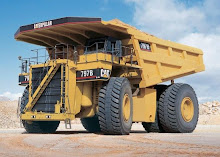Transportation
The engine, frame, axles and differential requires six to seven semi-trailer truck loads, the cab requires one semi-trailer load, the six tires require two semi-trailer loads and the dump body requires four semi-trailer loads. In total, one 797 requires 12 to 13 semi-trailer truck loads that originate at various manufacturing facilities and deliver to the customer site. If a 797 must be moved from one job site to another for any reason, it can not be driven on public roads due to its exceptional size and weight. Moving a 797 requires dis-assembly, loading onto semi-trailer trucks, transport and re-assembly at the new location.
Final Assembly
Final assembly of the 797 is completed by Caterpillar field mechanics at or near the customer site. Before the dump body can be joined to the frame, the dump body components must be assembled and welded together by a dedicated team, requiring seven to ten days per dump body. Final assembly of one 797 requires a team of seven mechanics working in three shifts around the clock, seven days per week for 20 days in addition to the time required to assemble and weld the dump body.



